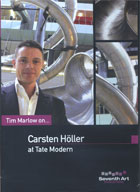
Tim Marlow on… Carsten Höller at Tate Modern 2006
Distributed by Seventh Art Releasing, 1614 N. Fairfax Ave., Los Angeles, CA 90046; 323-845-1455
Produced by Amanda Wilkie
Directed by Phil Grabsky and Ben Harding
DVD, color, 39 min.
Sr. High-General Adult
Art, Artist Installations, Museums
Date Entered: 07/13/2012
Reviewed by Barbara J. Walter, Longmont Public Library, Longmont, CO… using slides on an everyday basis could change us, just as other commodities are changing us. For instance, I’m convinced that the use of cars has changed our perception of time. I could imagine slides having an impact too. The state of mind that you enter when sliding, of simultaneous delight, madness and ‘voluptuous panic’, can’t simply disappear without trace afterwards. In this sense the ‘test site’ isn’t just in the Turbine Hall, but is also, to an extent, in the slider or person watching who’s stimulated by the slides: a site within.From artist’s concept to opening day, Tim Marlow on… Carsten Höller at Tate Modern sheds light on the process of designing and installing a large-scale work that challenges our traditional relationship with art, inviting us as spectators to become part of the spectacle.
-- Carsten Höller
In 2006 the Tate’s curators invited German artist Carsten Höller to present a work for the annual Unilever Series exhibition in Turbine Hall, a vast multistory space within this former London power station turned art museum. Höller proposed a playful yet thought-provoking work called Test Site, a set of five stainless steel slides for moving visitors on upper floors of the Tate down to ground level in Turbine Hall.
Through interviews with the artist and curators, host Tim Marlow explains how the space itself dictates the sort of artist chosen for the Unilever Series; the vision this particular artist has for drawing viewers into participating in his art, and how this installation serves as a model for people-moving possibilities outside the Tate. Negotiations between Höller, the lighting engineer and construction crew highlight the fact that while the artist conceives of and plans this massive installation, there is a point at which he must let go and allow people tasked with its construction to complete his work. And his tense discussions with Tate staff suggest that no one involved with the project entirely grasps the enormity of it—the budget is pushed to the limit.
As time-lapse photography shows the work taking shape within Turbine Hall, Marlow interviews Vincente Todoli and Nicholas Serota, directors at Tate, who observe how the installation plays with the hall’s height and boxiness, transforming it so that visitors can experience the space in an entirely new way. Adrian Hardwick, in charge of public safety at the Tate, describes the difficulties the work presents, admitting he and his staff will have to be fast on their feet to deal with the uncertainties involved in moving people about the building with slides. And Höller muses on the uncertainty involved for people who choose to ride the slides—how you must give yourself into the void, an irrational act rather like jumping off a cliff.
Opening night arrives along with the press, and plenty of them choose to ride the slides—cameras taken into the slides give a sense of the speed, exhilaration and disorientation that accompanies a descent to the floor of Turbine Hall. Later, visitors to the exhibit declare Test Site a smashing success for challenging their perception of what art is, allowing them to experience art in their bodies, and making everyone smile, whether sliding or watching others slide.
The film moves at a crisp pace, and is ideal for classroom use to introduce the artist and his oeuvre, installation art and the concept of participatory art.